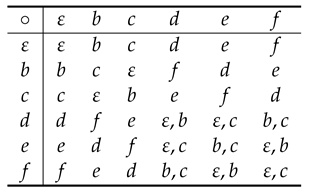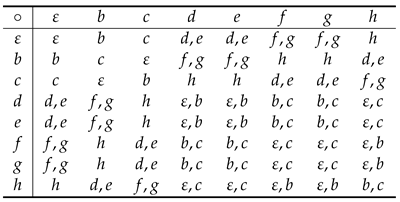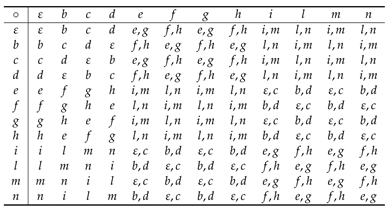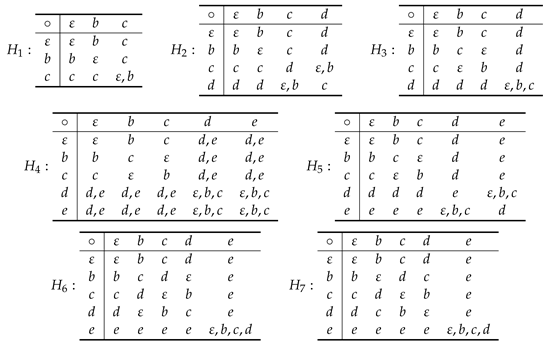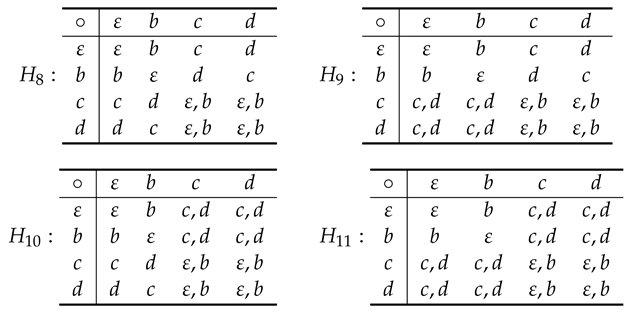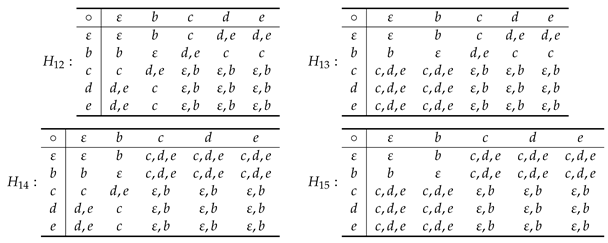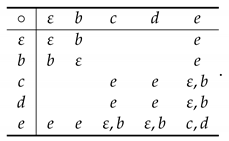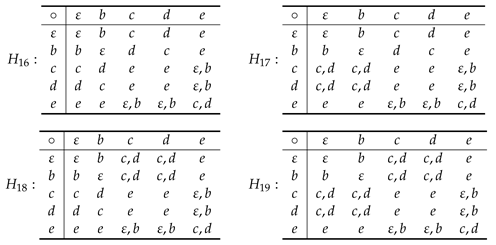1. Introduction
Hypercompositional algebra is a branch of Algebra that falls under the many generalizations of group theory [
1]. Therefore, it is not surprising that there is a great deal of overlap between the tools and problems of group theory and those of hypergroup theory. In fact, one of the best developed research areas in hypergroup theory is that of their classification. Although a complete classification of hypergroups is well beyond any current research horizon, several important results have been obtained in characterizing classes of hypergroups having certain properties. For example, the class of
D-hypergroups consists of those hypergroups that are isomorphic to the quotient set of a group with respect to a non-normal subgroup, and is a subclass of cogroups [
2,
3,
4], and cogroups appear as generalizations of
C-hypergroups, that were introduced as hyperstructures having an identity element and a weak form of the cancellation law [
5,
6].
A strong link between group theory and hypergroup theory is established by the relation
, which is the smallest equivalence relation defined on a hypergroup
H such that the corresponding quotient set
is a group [
7,
8,
9]. This relation is a very expressive tool for classifying significant families of hypergroups. In particular, the
-class of the identity of the quotient group
is called heart [
10,
11,
12]. The heart is a special sub-hypergroup of
H that gives detailed informations on the partition of
H determined by
. Notably, a 1-hypergroup is a hypergroup whose heart consists of only one element [
13,
14]. In this case, that element is also the identity of the hypergroup. In [
15,
16], the authors characterized 1-hypergroups in terms of the height of their heart and provided a classification of the 1-hypergroups with
based on the partition of
H induced by
. By means of this technique, the authors were able to enumerate all 1-hypergroups of size up to 6 and construct explicitly all non-isomorphic 1-hypergroups of size up to 5.
Motivated by these studies, in this paper we consider the class of hypergroups whose heart is isomorphic to a group. These hypergroups are called
G-hypergroups. Clearly, this class contains that of 1-hypergroups as the heart of a 1-hypergroup is the trivial group. The plan of this paper is the following. In the next section, we introduce basic definitions and notations to be used throughout the paper. In
Section 3, we introduce
G-hypergroups and their main properties, and give a flexible construction of
G-hypergroups that allows to prescribe arbitrarily both the heart and the quotient group
. Moreover, we analyze
G-hypergroups whose the heart is isomorphic to a torsion group. We denote this sub-class of
G-hypergroups with
. If
then the identity
of
is also identity of
, that is
for all
. Consequently, we prove that the singleton
is an invertible sub-hypergroup of
and the family of right (or left) cosets
(or
, respectively) is a partition of
H. Moreover, all
-classes are a disjoint union of right (left) cosets of
. In
Section 4, we analyze the main properties of the stabilizers of special actions of
on the set families
and
. These stabilizers play an important role in the construction of multiplicative tables of
G-hypergroups, as they fix the hyperproducts
and
for all
and
. The results of
Section 5 concern products of elements
such that
. In
Section 6, we characterize the
G-hypergroups in
that are of type
U on the right. Moreover, we find a sufficient condition for a
G-hypergroup of type
U on the right to be a cogroup. Finally, in
Section 7, we classify the
G-hypergroups of size
and
. Apart of isomorphisms, all the multiplicative tables of these hypergroups are listed and, using the results on 1-hypergroups found in [
16], we conclude that there are 48 non-isomorphic
G-hypergroups of size
.
2. Fundamentals of Hypergroup Theory
Throughout this paper, we will use standard definitions of fundamental concepts in hyperstructure theory, such as hyperproduct, semi-hypergroup, hypergroup, and sub-hypergroup, see, e.g., in [
17,
18,
19]. To keep the exposition self-contained, we recall below some auxiliary definitions and results that will be needed in the sequel.
A sub-hypergroup K of a hypergroup is invertible on the right (resp., on the left) if for all , (resp., ). Moreover, if K is invertible both on the right and on the left then it is called invertible.
A sub-hypergroup K of a hypergroup is said to be conjugable if for all there exists such that .
An element of a semihypergroup is an identity if , for all . Moreover, if then is a scalar identity.
Given a semihypergroup
, the relation
of
H is the transitive closure of the relation
, where
is the diagonal relation in
H and, for every integer
,
is defined as follows:
The relations
and
are among the so-called fundamental relations [
7,
9,
11,
20]. Their relevance in hyperstructure theory stems from the following facts. If
is a semihypergroup (resp., a hypergroup), then the quotient set
endowed with the operation
for
and
is a semigroup (resp., a group) [
21,
22]. The canonical projection
verifies the identity
for all
, that is,
is said to be a good homomorphism. Moreover, if
is a hypergroup then
is transitive [
8],
is a group and the kernel
of
is the heart of
.
If
A is a non-empty set of a semihypergroup
, then we say that
A is a complete part if for every
and
,
The transposed hypergroup of a hypergroup is the hypergroup where for all .
For later reference, we collect in the following theorem some classic results of hypergroup theory, see in [
8,
17].
Theorem 1. Let be a hypergroup. Then,
- 1.
the relation β is transitive;
- 2.
if K is a subhypergroup invertible on the right (resp., on the left) of , then the family (resp., ) is a partition of H;
- 3.
a subhypergroup K of is a complete part if and only if it is conjugable;
- 4.
the heart is the intersection of all conjugable subhypergroups (or complete parts) of ;
- 5.
the heart is a reflexive subhypergroup of , that is, .
3. -Hypergroups
The heart of a hypergroup
allows us to explicitly compute the partition determined by
, as
for all
. For this reason, the heart of hypergroups has been the subject of much research, in particular, to characterize it as the union of particular hyperproducts [
12]. A special class of hypergroups is that of 1-hypergroups, where the heart is a singleton. Clearly, the heart of a 1-hypergroup is isomorphic to a trivial group and if
then the element
is an identity since
. Other relevant results on 1-hypergroups can be found, e.g., in [
13,
14,
15,
16]. In this section, we will study the main properties of hypergroups whose heart is isomorphic to a group
G, which we call
G-hypergroups.
Notably, the class of
G-hypergroups is closed under direct product. Indeed, if
and
are
G-hypergroups then the direct product
is a
G-hypergroup as
. Indeed, for all
, we have
. Non-trivial examples of
G-hypergroups can be built by means of the construction shown in Example 2 of [
15], which we recall hereafter. Let
be the automorphism group of a hypergroup
. For
, let
denote the subgroup of
generated by
f. In
, define the following hyperproduct: for
, let
with respect to this hyperproduct
is a hypergroup whose heart is
. Clearly, if
is a
G-hypergroup then also
is a
G-hypergroup.
3.1. A Construction of G-Hypergroups
Let
T and
G be groups with
. Consider a family
of non-empty and pairwise disjoint sets such that
and
, for all
. In these hypotheses we pose
, for all
. In the set
we consider the hyperproduct
defined as follows: for all
,
We note that, by definition of hyperproduct ∘, we have
and
for all
. Moreover, for every
and
we obtain
Indeed, if then . Otherwise, if then . Moreover, if and then we obtain . By analogous arguments, we can deduce that . These simple remarks yield the basis of the following result, where we prove that is a G-hypergroup with some special properties.
Theorem 2. In the previous notations, the hyperoperation ∘ defined in (1) is associative. Moreover, we have - 1.
for every integer and for every , there exists such that ;
- 2.
for all there exist such that ;
- 3.
is a hypergroup such that ;
- 4.
and , for all and ;
- 5.
.
Proof. Let , and with . If then we have immediately since is a group. Otherwise, we have the following cases:
Only two of the three elements coincide with ;
Only one of the three elements coincides with ;
.
In the first case, if we assume that and , then we have .
If and , we obtain .
If and , we have .
In the second case, suppose and , we have .
If and , we obtain because , and .
If and , we deduce as , and .
In the last case we have . Thus, ∘ is associative. Now, we complete the proof of the remaining claims.
- 1.
To prove this claim it suffices to proceed by induction on
n, based on (
2) and the associativity of hyperproduct ∘.
- 2.
Let . If then we have , for all and . If , since , there exists such that and so , for all and .
- 3.
To prove that
is a hypergroup we only need to prove reproducibility. Let
. As
, using (
2) we obtain
Analogously, we can prove that
for every
. Now, being
a hypergroup, we have the chain of inclusions
Thus, if then there exists such that . For points and , there exist and such that , so we obtain .
- 4.
Clearly
is a subhypergroup of
H. Moreover,
G is conjugable as for all
and
there exists
such that
. By point
of Theorem 1, we have
. Moreover,
because
is a complete part of
H and
. Finally, by (
2) we have
, for all
and
.
- 5.
The application such that is a group isomorphism.
□
3.2. If G Is a Torsion Group
In this subsection, we denote by
the identity of the heart of a
G-hypergroup
. Moreover, we denote by
the class of
G-hypergroups whose heart is a torsion group. For each element
x of a hypergroup
, we identify
with the singleton
and, for any integer
, we set
The set
is the cyclic semihypergroup generated by
x. This hypercompositional analogue of cyclic semigroups has attracted the interest of many researchers, being a powerful tool for the construction and study of remarkable families of hypergroups. We point the interested reader to the detailed reviews in [
23,
24].
In what follows, we exploit cyclic sub-semihypergroups to derive some properties of hypergroups in . Specifically, we prove that the identity of the heart of a hypergroup is an invertible sub-hypergroup of . We will use these properties in the subsequent section to describe the group actions of on families of hyperproducts and for and .
Theorem 3. Let . Then, ε is an identity of .
Proof. Let . There exists such that by reproducibility of . Moreover, and, by an inductive argument, for all . Finally, as is a torsion group, there exists such that , thus . By analogous arguments we also have . □
Proposition 1. Let an G-hypergroup and . The following conditions are equivalent:
- 1.
(resp., ) for all ;
- 2.
(resp., ) for all and .
Proof. Let and . The thesis is obvious if , so let and . We have and so . Moreover, . Hence . Consequently, . Therefore . In the same way we prove that if for all .
The converse implication, , is an immediate consequence of Theorem 3. □
Corollary 1. Let . Then ε is a left scalar identity (resp., right scalar identity) of if and only if (resp., ), for all and .
Theorem 4. Let . If S is a finite sub-semihypergroup of then we have:
- 1.
;
- 2.
S is a sub-hypergroup of .
Proof. Let be the canonical projection. As S is finite, there exists such that has minimal size.
If then . Hence and . As is a torsion group, there exists a positive integer n such that and so .
If then there exists such that . Clearly, we have and consequently as has minimal size. Therefore, and there exists a integer such that . Therefore, there exists such that and . Thus, and . Finally, there exists a integer positive m such that and .
We must show that
, for all
. By point
and Theoreme 3,
and
is identity in
. Therefore, we have
and so
. Now, if
, the subset
is a finite sub-semihypergroup of
as
S is finite,
and
. Thus, for point
, we obtain
. Finally,
Therefore, for all . In the same way we prove that . □
Theorem 5. Let . The singleton is a invertible sub-hypergroup of .
Proof. We prove that is invertible on the left, that is , for all . In the same way, it is proved that S is invertible on the right. Let . If , we have and . Now, we suppose . Clearly, we have . Moreover, we obtain and so . Therefore, there exists such that . Consequently, and . By induction, we deduce that , for all integer . As is a torsion group, there exists a positive integer m such that and so . □
Remark 1. The invertibility on the left (resp., on the right) of the sub-hypergroup implies that the family of right cosets (resp., left cosets) of is a partition of H. Since for each element y of a β-class we have (resp., ), then every β-class is a disjoint union of right cosets of S (resp., left cosets of S).
3.3. The Cosets of
As suggested by Remark 1, the families of right and left cosets of are relevant to determine the structure of G-hypergroups in . In this subsection we deepen the knowledge of these cosets. We will only do proofs for right cosets because properties that are true for a hypergroup are also true for its transposed hypergroup.
Proposition 2. Let . For all and we have:
- 1.
;
- 2.
;
- 3.
;
- 4.
;
Proof. The implication ⇐ is a consequence of Theorem 3. Now, suppose that . Clearly, we have . Moreover, and, by induction, we obtain the chain of inclusions As is a torsion group, there exists a positive integer m such that and so . Therefore, .
Concerning point , it is enough to prove the implication ⇒. Let . As is a invertible subhypergroup of H, we have and so . Therefore, by point , we obtain . Consequently, we deduce .
Points and follow from and by considering the transposed hypergroup of . □
Proposition 3. Let . For all and we have
- 1.
;
- 2.
;
- 3.
if , then ;
- 4.
;
- 5.
;
- 6.
if , then .
Proof. The implication ⇐ is a consequence of the Theorem 3. Let . We have . Taking an element , we obtain . Therefore, for invertibility of subhypergroup in , . Consequently, as , we deduce and so .
Let . By point of Proposition 3, we have and . Therefore, .
As , by point of Proposition 3, we have and so . Consequently, .
Points , , and follow from , , and by considering the transposed hypergroup of . □
4. Actions of
If is a group action of G on the set E, the sets and are the orbit and the stabilizer of element , respectively. The orbits family is a partition of E and the stabilizer is a subgroup of G. If e and belong to the same orbit the stabilizers are conjugates. Moreover, we have and when G is finite we obtain that divides the size of G.
If
, we denote by
and
the following sets:
On
and
we consider the actions
e
such that
for all
,
and
.
For simplicity, let and be the stabilizer and the orbit of with respect to the action , and let and be those with respect to .
If
then there exists
such that
. By Proposition 3, we deduce
. Conversely, again for the Proposition 3, if
and
we have
with
. Therefore, we obtain
Next, we establish a connection between the sizes of , , , and . For brevity, we only expose results for the action . The corresponding results for the action follow trivially by recurring to transposed hypergroups.
Lemma 1. Let and .
- 1.
(resp., ) if and only if (resp., ), for all and ;
- 2.
if (resp., ) then (resp., ;
- 3.
(resp., ) if and only if (resp., ).
Proof. If then and, by Proposition 3, , for all and . Conversely, if then and by hypothesis.
By point , we have and so . Moreover, as the hyperproducts in have size and , for all , we deduce .
If then , for all . Therefore, . Conversely, if then and , for all . Hence . □
Proposition 4. Let and let x be an element of such that (resp., ), for every . Then and equality holds if and only if (resp., ).
Proof. By Proposition 1, we have , for every and . Therefore, . Now, if then by point of Lemma 1. Conversely, if , then , for all and . Thus, by point of Lemma 1, . □
A consequence of the previous proposition is the following result:
Theorem 6. Let be such that ε is a left scalar identity and , for all (resp., ε is a right scalar identity and , for all ). Then , for all . Moreover, if is finite then .
Now, if and , we denote by and the following sets: Clearly, we have and .
Proposition 5. If and then the following conditions are equivalent:
- 1.
(resp., );
- 2.
;
- 3.
(resp., ).
Proof. If then there exists such that , and so . Thus . On the other hand, if then and there exists such that . By point of Proposition 3, we have and so .
Let
. By (
3),
and
since the orbits are a partition of
. Now, let
. There exist
and
such that
. Consequently, we have
and
. □
Proposition 6. Let and let such that . Then, we have
- 1.
(resp., );
- 2.
the subgroups and (resp., and ) are conjugates;
- 3.
if or (resp., or ) is a normal subgroup or is abelian, then (resp., );
- 4.
;
- 5.
.
Proof. By Proposition 5, the sets and are not empty as . Fixed an element , we have for all . Therefore, and . Clearly, the application such that , for all , is injective and so . On the other hand, as , we obtain . Therefore, . Finally, the application such that , for all , is injective and so .
By Proposition 5, we have . Thus, the elements , of belong to the same orbit. Consequently, the stabilizers and are conjugates.
Point is an immediate consequence of , and points and follow from and because conjugated subgroups have the same size. □
An immediate consequence of point in Proposition 6 is the following result:
Corollary 2. Let and let x, y be elements of such that . Then,
- 1.
(resp., );
- 2.
(resp., ).
5. Properties of the Hyperproducts
with
In this section, we prove certain properties of products of elements such that . These properties will be utilized in the next section in the construction of G-hypergroups of small size. Note that , for all as is a complete part of H by point 4. of Theorem 1.
Proposition 7. Let and let such that . If and (alternatively, if and ) then .
Proof. Let
and
. By Lemma 1 we have
. Thus,
Moreover, we have
because
is a reflexive subhypergroup of
. Now, by hypothesis, two cases are possible:
or
. If
then
follows by transposing the previous arguments, and the claim follows. On the other hand, if
then, by Lemma 1, we have
for all
and
. Consequently, if by absurd we suppose that
then we deduce the contradiction
Therefore, also in this case and . When and the claim follows by transposition. □
Remark 2. If the heart of a hypergroup is isomorphic to a group of size a prime number p then , for every . In this case, if , and at least one of the subgroups is different from , then . This fact is not true if . For example, consider the hypergroup represented by the following table: Here, , , and . Recall that the 1-hypergroups are a special class of G-hypergroups and their sub-hypergroups are conjugable. The same property is not true if the heart of a G-hypergroup is not trivial. Indeed, if ε is the identity of the heart then is a non-conjugable sub-hypergroup of H. On the other hand, there are G-hypergroups that have non-trivial non-conjugable sub-hypergroups. For instance, the hypergroup of the previous table has five non-trivial sub-hypergroups different from H and , that is, , , , , . Note that and are isomorphic to and are not conjugable.
Proposition 8. Let and let such that . Then, .
Proof. We have as . If then and so . Therefore, . In the same way, we prove that . □
An immediate consequence of Propositions 7 and 8 is the following:
Corollary 3. Let and let such that . If is isomorphic to a group of size a prime number and or , then .
Proposition 9. Let and let such that . Then, , for all and .
Proof. By hypothesis . Moreover, as and , there exist such that and . By Proposition 3, we have and . As , we have . Finally, the application such that , for all , is bijective and so . □
Lemma 2. Let and let P be a normal subgroup of . Moreover, let and . Then, we have
- 1.
if , then for all there exists such that ;
- 2.
if and then .
Proof. Let . If , there exists such that . Now, taken , we have . Moreover, as P is a normal subgroup and , we deduce .
By absurdity, let . As and , we have . Now, let . Clearly, if then . If , we have and, by point , there exists such that . Hence, P is a conjugable subhypergroup of and we have ; impossible as . □
Proposition 10. Let such that and . We have
- 1.
, for all ;
- 2.
if there exists such that or , then , for all ;
- 3.
if then , for all .
Proof. By hypothesis is a proper normal subgroup of and , for all . If there exist such that , we can suppose that , with . Therefore, we have , that is impossible by point of Lemma 2.
Let and . For reproducibility, there exists such that . By Proposition 8, we have . Consequently, from Proposition 9, we deduce , for all . We get the same result if .
is an immediate consequence of □
Corollary 4. Let and let x be an element of such that . If is finite and is a group of size a prime number p then , for all and . Moreover, if then , for all .
Proof. Since is a prime number p and , by Lemma 1, and . Now, if , and (resp., ), by Proposition 3, we have (resp., ). Furthermore, by Proposition 10, if and then . □
Example 1. In the next table we show a hypergroup such that , , and all hyperproducts have size 2, for all . According to Proposition 10, necessarily we have here and , for all .
In the previous example, each element of the heart is contained in exactly six hyperproducts . This fact finds full justification in the next proposition. A new notation is entered: For all such that and , let . Clearly, as .
Proposition 11. Let , and . If , for all (resp., , for all ), then is the same for all .
Proof. Let . There exists such that . Clearly, , with by Proposition 1. Moreover, if then and so . Finally, the application such that , with , is injective because , for all . Therefore, . Similarly, we have . □
Corollary 5. Let be a finite hypergroup in , and let such that . If , for all (resp., , for all ), then for all , and . In particular, if is a prime number then or divides or .
Proof. Let . By Proposition 9, for all and . Thus, taking and , by Proposition 11 and , we obtain counting in two different ways. Finally, as , if is a prime number then or divides or . □
In Proposition 11, the hypothesis
for all
is essential. Indeed, consider the following hypergroup:
Here, we have , , and . In this example, Proposition 11 cannot be applied because .
6. Hypergroups of Type in
Among the best-known classes of hypergroups are undoubtedly those of type
U, type
C, and the cogroups. A hypergroup of type
U on the right is a hypergroup
with a right scalar identity
that fulfills the condition
, for all
, see [
25,
26,
27]. A hypergroup of type
C on the right is a hypergroup
of type
U on the right that fulfills the condition
, for all
, see [
5,
6]. A cogroup on the right is a hypergroup of type
C on the right such that
for all
, see in [
2,
3,
4]. The transposed of a hypergroup of type
U on the right is a hypergroup of type type
U on the left, and analogously for hypergroup of type
C and cogroups. The purpose of this subsection is to characterize the hypergroups in
that are of type
U on the right or cogroups on the right. We have the following result:
Theorem 7. Let . Then, is of type U on the right if and only if and , for all .
Proof. If is of type U on the right, , and then and so we have . Conversely, let and , for all . If are elements of H such that then . Indeed, if is the canonical projection then and . Clearly, if then because and is isomorphic to a group. If then, using Proposition 2, we have and . Thus, and so is of type U on the right. □
We note that if is a 1-hypergroup of type U on the right then and as is a right scalar identity. In this case H is isomorphic to a group. Consequently, we have the following result.
Corollary 6. A hypergroup is isomorphic to a group if and only if is a 1-hypergroup of type U on the right.
In reference to Theorem 7 and the previous corollary, we note that the hypergroup shown in Example 1 is of type U both on the right and on the left. Indeed, in that hypergroup we have , and , for all . The next result provides a sufficient condition for a hypergroup of type U on the right to be also a cogroup.
Theorem 8. Let be of type U on the right. If for all then is a cogroup.
Proof. The thesis is obvious if is a group. Therefore, we suppose that . Let , for all . If , we obtain and so . Hence, if and only if . Now, if , by point of Lemma 1, then . If and , by point of Proposition 3, we obtain and so as is of type U on the right. Therefore, and . We get the same result if we suppose that . Thus, is of type C on the right. Now, we distinguish two cases to prove that , for all . We note that, by Theorem 6, we have that , for all .
If
then we have
by Corollary 1. On the other hand, if
and
then, from point
of Lemma 1, we have
and so
Finally, as , for all , we obtain that , for all . Therefore, . Thus, if and then and the proof is over. □
The hypothesis
in Theorem 7 is sufficient but not necessary for a hypergroup of type
U on the right to be a cogroup. Indeed, the following hypergroup is a cogroup on the right in
but
, for all
.
In this case the heart is isomorphic to and for all .
7. -Hypergroups of Minimal Size
In [
16] the authors classified the 1-hypergroups of size
. Hereafter, we classify the
G-hypergroups of size
and
, apart of isomorphisms. Recall that
denotes the identity of
G. Furthermore, let
be the subclass of
such that
,
and
. With these notations, using the results in
Section 3, we classify the hypergroups of the subclasses
with
,
,
and
.
Apart of isomorphisms, the classes
,
,
,
,
,
, and
consist of only one hypergroup. We list their tables respecting the order in which the previous classes are written.
We note that the table of hypergroup in is a consequence of Corollary 4. The other tables are deduced by considering the quotient group .
Class:
. Using the Propositions 6 and 10, we have the following four hypergroups, apart of isomorphisms:
According to Theorems 7 and 8, and Corollary 6,
is a hypergroups of type
U on the right and on the left,
is a cogroup on the left and
is a cogroup on the right. We note that if
is a group and
S is a non-normal subgroup of
G then the quotient
(resp.
) is a hypergroup with hyperproduct
(resp.
). These hypergroups are called
D-hypergroups [
3]. The hypergroups
and
are isomorphic to
and
respectively, being
is the dihedral group of size 8 and
S is a non-normal subgroup of size 2. Moreover,
can be obtained from the construction shown in
Section 3.1 with
.
Class:
. The element
is not a left scalar identity (resp., right scalar identity) otherwise, by Proposition 1, we have
, for all
and
. Consequently, as
, if
then we have the contradiction
. Furthermore, in this case, using the Propositions 6 and 10, we obtain the following four hypergroups, apart of isomorphisms:
Class:
. If the
-classes are
,
and
, the quotient group
returns the partial table:
By Propositions 2 and 6, we obtain the following four tables, apart of isomorphisms:
Class:
. Apart of isomorphisms, we obtain two hypergroups according to that
is isomorphic to
or
.
Therefore, the following result is obtained:
Theorem 9. There are 21 non-isomorphic G-hypergroup of size and , as summarized in Table 1. The
G-hypergroups with
are 1-hypergroups, which include groups. In [
16], the authors classified the 1-hypergroups of size
. In particular, those of size
are 27. Thus, we have the following result.
Corollary 7. There are 48 non-isomorphic G-hypergroup of size .
Remark 3. In every G-hypergroup with all subgroups satisfy the condition that or . On the other hand, the hypergroup shown in Remark 2 has order 6 and contains a subgroup S such that neither nor . Therefore, that hypergroup is minimal with respect to this property.
8. Conclusions and Directions for Further Research
If
is a hypergroup then the kernel
of the canonical projection
is a sub-hypergroup called heart [
10,
12]. If
then
is a 1-hypergroup [
13,
14,
16]. However, very little is known about hypergroups that have a heart that does not consist of either a single element or the entire hypergroup. This paper provides a contribution to the knowledge of such hypergroups. To achieve this goal, we generalized the notion of 1-hypergroup to hypergroups whose heart is isomorphic to a group. We analyzed in detail this class of hypergroups, here called
G-hypergroups, with a special emphasis on the sub-class
of
G-hypergroups whose heart is a torsion group. In the future, these results can hopefully lead to a more general construction than the one presented in
Section 3.1, allowing all
G-hypergroups to be constructed.
Among our main results, we characterized the
G-hypergroups that are also of type
U on the right or cogroups on the right. Furthermore, we enumerated all non-isomorphic
G-hypergroups with
. The results achieved in
Section 7 describe all
G-hypergroups with
and
, and are condensed in
Table 2. We note that the hypergroups
and
are also cogroups. Cogroups are one of the best known classes of hypergroups. A most notable problem with them is characterizing cogroups that are also
D-hypergroups, i.e., quotient hypergroups
of a group
G with respect to a non-normal subgroup
S. This problem was solved in greater generality by L. Haddad and Y. Sureau in [
3,
4] by considering the group of permutations
of
H such that
, for all
. The cogroups
and
are
D-hypergroups isomorphic to
and
, respectively, being
the dihedral group of size 8 and
S a non-normal subgroup of size 2.
At the conclusion of this work we would like to indicate some possible topics for further investigation. First of all, it would be interesting to verify whether the cogroups in
are also
D-hypergroups. A challenging problem related to the research carried out, e.g., in [
16], which is classifying
G-hypergroups of size greater than 5.
Finally, we observe that all
G-hypergroups
produced by the construction shown in
Section 3.1 are such that the identity of
is also identity of
, also when
is not a torsion group. At present, we are not able to prove or disprove that this is always the case. Hence, a problem that remains open after our findings can be formulated as the following conjecture: if
is a
G-hypergroup then the scalar identity of
is also the identity of
.

